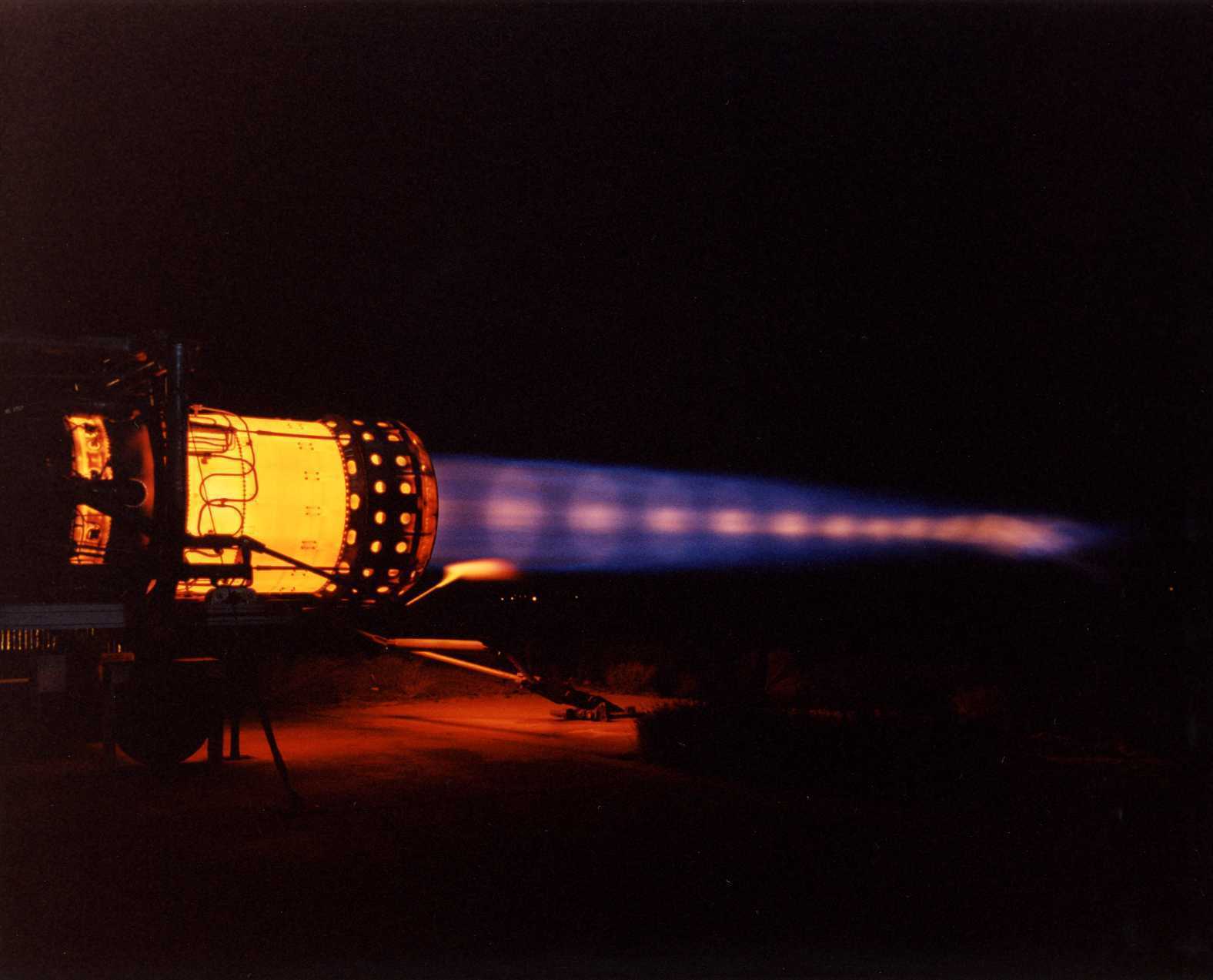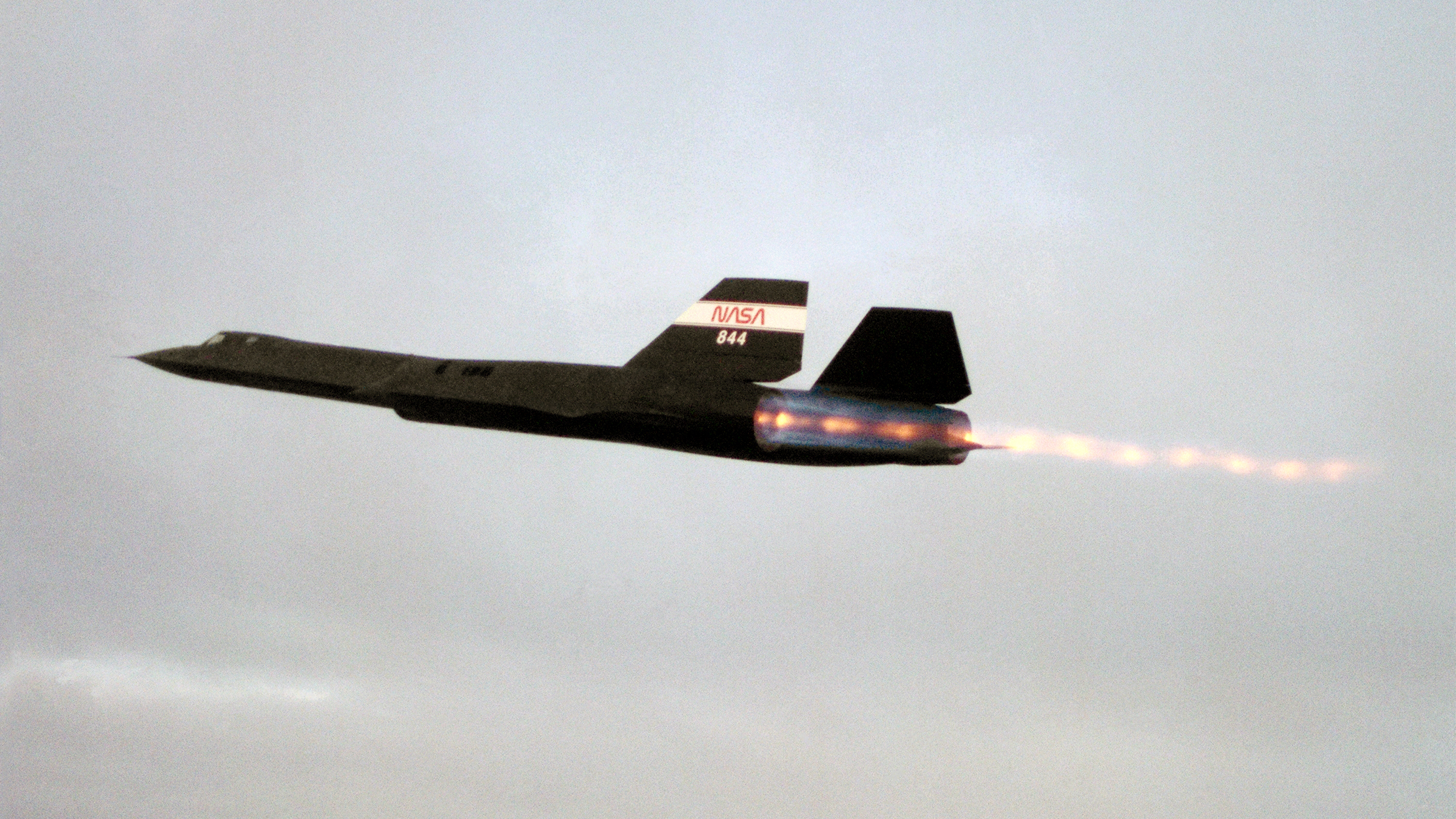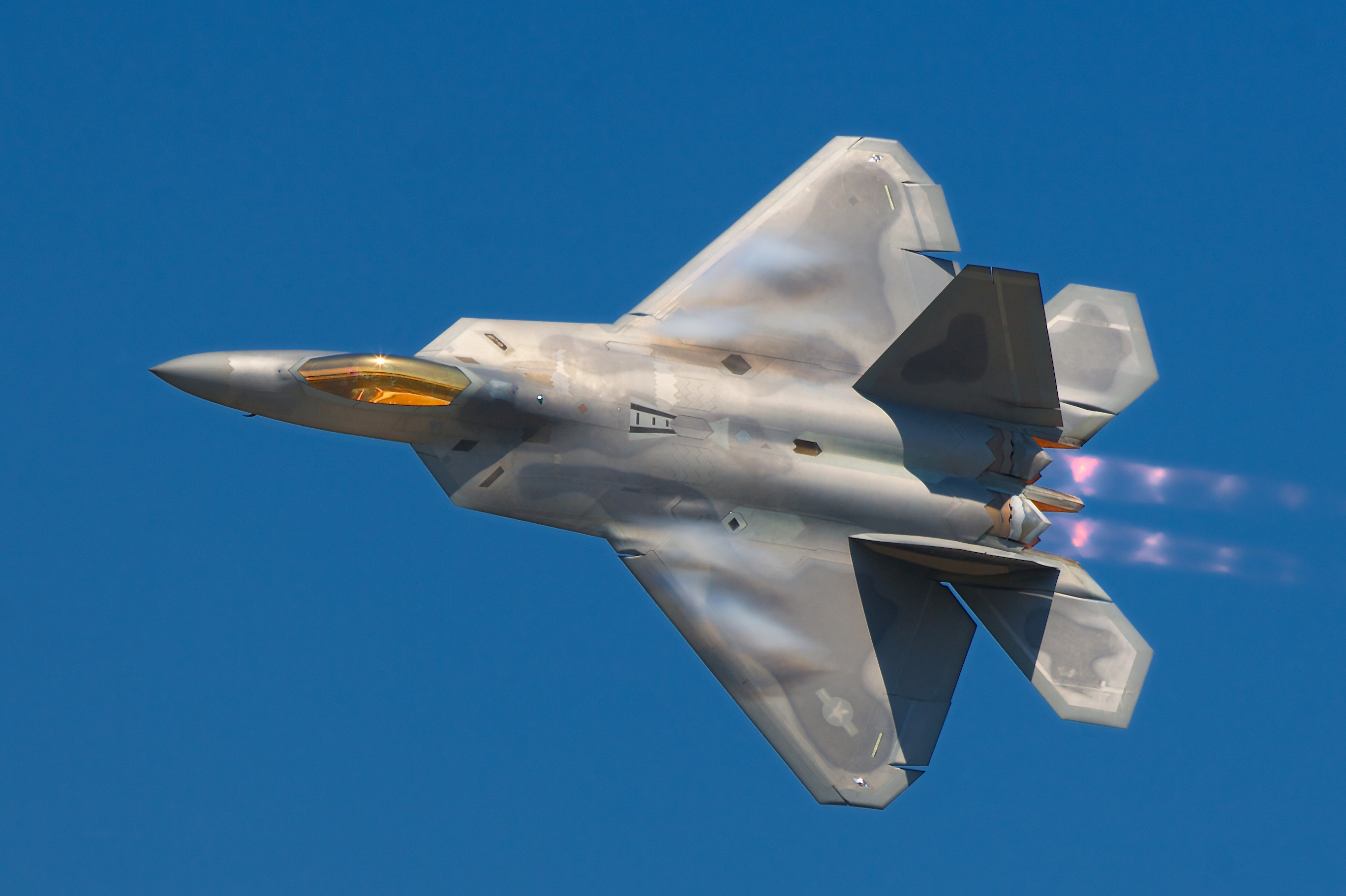Mach disk on:
[Wikipedia]
[Google]
[Amazon]
 Shock diamonds (also known as Mach diamonds or thrust diamonds) are a formation of standing wave patterns that appear in the supersonic exhaust plume of an aerospace propulsion system, such as a supersonic jet engine,
Shock diamonds (also known as Mach diamonds or thrust diamonds) are a formation of standing wave patterns that appear in the supersonic exhaust plume of an aerospace propulsion system, such as a supersonic jet engine,



 Shock diamonds form when the supersonic exhaust from a
Shock diamonds form when the supersonic exhaust from a
 Shock diamonds are most commonly associated with jet and rocket propulsion, but they can form in other systems.
Shock diamonds are most commonly associated with jet and rocket propulsion, but they can form in other systems.
"Methane blast"
- shock diamonds forming in NASA's methane engine built by
"Shock Diamonds and Mach Disks"
- This link has useful diagrams. Aerospaceweb.org is a non-profit site operated by engineers and scientists in the aerospace field. Physical phenomena Shock waves Aerospace Aerodynamics
 Shock diamonds (also known as Mach diamonds or thrust diamonds) are a formation of standing wave patterns that appear in the supersonic exhaust plume of an aerospace propulsion system, such as a supersonic jet engine,
Shock diamonds (also known as Mach diamonds or thrust diamonds) are a formation of standing wave patterns that appear in the supersonic exhaust plume of an aerospace propulsion system, such as a supersonic jet engine, rocket
A rocket (from it, rocchetto, , bobbin/spool) is a vehicle that uses jet propulsion to accelerate without using the surrounding air. A rocket engine produces thrust by reaction to exhaust expelled at high speed. Rocket engines work entirely fr ...
, ramjet
A ramjet, or athodyd (aero thermodynamic duct), is a form of airbreathing jet engine that uses the forward motion of the engine to produce thrust. Since it produces no thrust when stationary (no ram air) ramjet-powered vehicles require an as ...
, or scramjet
A scramjet (supersonic combustion ramjet) is a variant of a ramjet airbreathing jet engine in which combustion takes place in supersonic airflow. As in ramjets, a scramjet relies on high vehicle speed to compress the incoming air forcefully ...
, when it is operated in an atmosphere. The "diamonds" are actually a complex flow field made visible by abrupt changes in local density and pressure as the exhaust passes through a series of standing shock wave
In physics, a shock wave (also spelled shockwave), or shock, is a type of propagating disturbance that moves faster than the local speed of sound in the medium. Like an ordinary wave, a shock wave carries energy and can propagate through a me ...
s and expansion fan
Expansion may refer to:
Arts, entertainment and media
* ''L'Expansion'', a French monthly business magazine
* ''Expansion'' (album), by American jazz pianist Dave Burrell, released in 2004
* ''Expansions'' (McCoy Tyner album), 1970
* ''Expansio ...
s. Mach diamonds are named after Ernst Mach, the physicist who first described them.
Mechanism



 Shock diamonds form when the supersonic exhaust from a
Shock diamonds form when the supersonic exhaust from a propelling nozzle
A propelling nozzle is a nozzle that converts the internal energy of a working gas into propulsive force; it is the nozzle, which forms a jet, that separates a gas turbine, or gas generator, from a jet engine.
Propelling nozzles accelerate the av ...
is slightly over-expanded, meaning that the static pressure
In fluid mechanics the term static pressure has several uses:
* In the design and operation of aircraft, ''static pressure'' is the air pressure in the aircraft's static pressure system.
* In fluid dynamics, many authors use the term ''static pres ...
of the gases exiting the nozzle is less than the ambient air pressure
Atmospheric pressure, also known as barometric pressure (after the barometer), is the pressure within the atmosphere of Earth. The standard atmosphere (symbol: atm) is a unit of pressure defined as , which is equivalent to 1013.25 millibars ...
. The higher ambient pressure compresses the flow, and since the resulting pressure increase in the exhaust gas
Exhaust gas or flue gas is emitted as a result of the combustion of fuels such as natural gas, gasoline (petrol), diesel fuel, fuel oil, biodiesel blends, or coal. According to the type of engine, it is discharged into the atmosphere through an ...
stream is adiabatic, a reduction in velocity causes its static temperature to be substantially increased. The exhaust is generally over-expanded at low altitudes, where air pressure is higher.
As the flow exits the nozzle, ambient air pressure will compress the flow. The external compression is caused by oblique shock wave
An oblique shock wave is a shock wave that, unlike a normal shock, is inclined with respect to the incident upstream flow direction. It will occur when a supersonic flow encounters a corner that effectively turns the flow into itself and comp ...
s inclined at an angle to the flow. The compressed flow is alternately expanded by Prandtl-Meyer expansion fans, and each "diamond" is formed by the pairing of an oblique shock with an expansion fan. When the compressed flow becomes parallel to the center line, a shock wave perpendicular to the flow forms, called a normal shock wave
In physics, a shock wave (also spelled shockwave), or shock, is a type of propagating disturbance that moves faster than the local speed of sound in the medium. Like an ordinary wave, a shock wave carries energy and can propagate through a med ...
or Mach disk. This locates the first shock diamond, and the space between it and the nozzle is called the "zone of silence". The distance from the nozzle to the first shock diamond can be approximated by
where ''x'' is the distance, ''D''0 is the nozzle diameter, ''P''0 is flow pressure, and ''P''1 is atmospheric pressure.
As the exhaust passes through the normal shock wave, its temperature increases, igniting excess fuel and causing the glow that makes the shock diamonds visible. The illuminated regions either appear as disks or diamond
Diamond is a solid form of the element carbon with its atoms arranged in a crystal structure called diamond cubic. Another solid form of carbon known as graphite is the chemically stable form of carbon at room temperature and pressure, ...
s, giving them their name.
Eventually the flow expands enough so that its pressure is again below ambient, at which point the expansion fan reflects from the contact discontinuity (the outer edge of the flow). The reflected waves, called the compression fan, cause the flow to compress. If the compression fan is strong enough, another oblique shock wave will form, creating a second Mach disk and shock diamond. The pattern of disks and diamonds would repeat indefinitely if the gases were ideal and frictionless; however, turbulent
In fluid dynamics, turbulence or turbulent flow is fluid motion characterized by chaotic changes in pressure and flow velocity. It is in contrast to a laminar flow, which occurs when a fluid flows in parallel layers, with no disruption between ...
shear at the contact discontinuity causes the wave pattern to dissipate with distance.
Diamond patterns can similarly form when a nozzle is under-expanded (exit pressure higher than ambient), in lower atmospheric pressure at higher altitudes. In this case, the expansion fan is first to form, followed by the oblique shock.
Alternative sources
 Shock diamonds are most commonly associated with jet and rocket propulsion, but they can form in other systems.
Shock diamonds are most commonly associated with jet and rocket propulsion, but they can form in other systems.
Natural gas pipeline blowdowns
Shock diamonds can be seen during gas pipeline blowdowns because the gas is under high pressure and exits the blowdown valve at extreme speeds.Artillery
When artillery pieces are fired, gas exits the cannon muzzle at supersonic speeds and produces a series of shock diamonds. The diamonds cause a brightmuzzle flash
Muzzle flash is the light — both visible and infrared — created by a muzzle blast, which is caused by the sudden release and expansion of high-temperature, high-pressure gases from the muzzle of a firearm during shooting. Both the blast ...
which can expose the location of gun emplacements to the enemy. It was found that when the ratio between the flow pressure and atmospheric pressure is close, which can be achieved with a flash suppressor
A flash suppressor, also known as a flash guard, flash eliminator, flash hider, or flash cone, is a muzzle device attached to the muzzle (firearms), muzzle of a rifle that reduces its visible signature while firing by cooling or dispersing the b ...
, the shock diamonds were greatly minimized. Adding a muzzle brake
A muzzle brake or recoil compensator is a device connected to, or a feature integral to the construction of, the muzzle or barrel of a firearm or cannon that is intended to redirect a portion of propellant gases to counter recoil and unwanted ...
to the end of the muzzle balances the pressures and prevents shock diamonds.
Radio jets
Some radio jets, powerful jets of plasma that emanate from quasars andradio galaxies
A radio galaxy is a galaxy with giant regions of radio emission extending well beyond its visible structure. These energetic radio lobes are powered by jets from its active galactic nucleus. They have luminosities up to 1039 W at radio wav ...
, are observed to have regularly-spaced knots of enhanced radio emissions. The jets travel at supersonic speed through a thin "atmosphere" of gas in space, so it is hypothesized that these knots are shock diamonds.
See also
*Plume (hydrodynamics)
In hydrodynamics, a plume or a column is a vertical body of one fluid moving through another. Several effects control the motion of the fluid, including momentum (inertia), diffusion and buoyancy (density differences). Pure ''jets'' and pure ''p ...
* Rocket engine nozzle
A rocket engine nozzle is a propelling nozzle (usually of the de Laval
Karl Gustaf Patrik de Laval (; 9 May 1845 – 2 February 1913) was a Swedish engineer and inventor who made important contributions to the design of steam turbines and cent ...
References
External links
{{Commons category, Shock diamonds"Methane blast"
- shock diamonds forming in NASA's methane engine built by
XCOR Aerospace
XCOR Aerospace was an American private spaceflight and rocket engine development company based at the Mojave Air and Space Port in Mojave, California, Midland International Air and Space Port, Midland International Air and Spaceport in Midland, T ...
, NASA website, 4 May 2007
"Shock Diamonds and Mach Disks"
- This link has useful diagrams. Aerospaceweb.org is a non-profit site operated by engineers and scientists in the aerospace field. Physical phenomena Shock waves Aerospace Aerodynamics